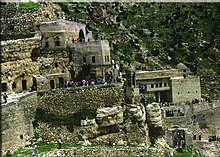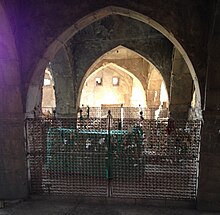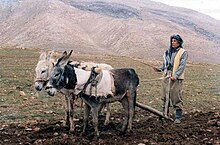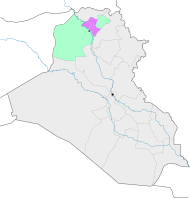Alqosh
Alqosh
ܐܲܠܩܘܿܫ ألقوش[1] | |
|---|---|
 Entry way sign, spelling "I ♡ Alqosh" | |
| Coordinates: 36°43′56″N 43°5′43″E / 36.73222°N 43.09528°E | |
| Country | |
| Governorate | Nineveh Governorate |
| District | Tel Kaif District[2] |
| Founded | 1500 BC |
| Time zone | GMT +3 |
| • Summer (DST) | GMT +4 |
Alqosh (Syriac: ܐܲܠܩܘܿܫ,[4][5][6] Jewish Babylonian Aramaic: אלקוש, Arabic: ألقوش,[1] alternatively spelled Alkosh, Alqoš, or Alqush) is a town in the Nineveh Plains of northern Iraq, a sub-district of the Tel Kaif District situated 45 km north of the city of Mosul.
The locals of Alqosh are Assyrians who since the 18th century now mostly adhere to the Chaldean Catholic Church.[7][8][9] During the Iron Age, the Alqosh plain appears to have been home to the small regional kingdom of Qumāne, but was subsequently annexed by Assyria.[10]
Landmarks
[edit]The town of Alqosh is set at the foot of a mountain known as ṭūrəd-‘Alquš meaning “the mountain of Alqosh”. In the vicinity, there are the kahfa/kāfa smōqa (the red cave), guppəd-naṭōpa (the cave of dripping), guppəd-māya (the cave of water), guppəd-saṭāna (the cave of Satan), guppa mgurəgma (the thundering cave), and a valley šwīṯəd-ganāwe (the bed of thieves) at the foot of Alqosh mountain.[11][12]
Behind the mountain there is also the site of Bezqin, known in Classical Syriac sources as ܒܙܩܝܢ bizqīn[13] and pronounced by modern Alqosh as bisqin, containing the remains of an orchard and a Syriac Orthodox monastery, which may have originally been part of the Church of the East, and containing springs. After the Simele Massacre this was left and came to be ruined by vandals, and most of the ancient trees cut down or burnt.[14][15][16][17]
Christianity
[edit]

The Assyrian people had gradually converted from Mesopotamian Religion to Eastern Rite Christianity between the 1st and 5th centuries AD. The importance of Alqosh for the Assyrian Church of the East arose from its proximity to the Rabban Hormizd Monastery, named after its seventh-century founder Rabban Hormizd (Rabban means "monk"), who is venerated as a saint in the churches descended from the Assyrian Church of the East.
The monastery, built on the mountain slope, was a centre of learning for the Church of the East not far from another centre but of the Syriac Orthodox Church. It was the burial place of the patriarchs of the Church of the East from the late fifteenth century and was their seat from the time of Shimun VI (1503–1538) until the end of the series of patriarchs known as the Eliya line.[18] Isolated and cut off by snow from Alqosh in winter, it never became their permanent residence,[17] and its line of patriarchs is commonly described as the Mosul line or as resident in Alqosh.[19]
In the schism of 1552, the abbot of the monastery, Yohannan Sulaqa, was elected irregularly to the post of patriarch by several bishops who were dissatisfied with the restriction of patriarchal succession to members of a single family. By tradition, a patriarch could be ordained only by someone of archiepiscopal (metropolitan) rank, a rank to which only members of that one family were promoted. For that reason, Sulaqa travelled to Rome, where, presented as the new patriarch-elect, he entered communion with the Catholic Church, was ordained by the Pope, and recognized as patriarch of the "Church of Mosul and Athura". He and his successors (who eventually formally broke communion with Rome) took up residence further east. This schism gave rise to the Chaldean Catholic Church, in opposition to what historians call the traditionalist wing of the Church of the East, that which officially adopted the name Assyrian Church of the East.[20][21]


In the 17th and 18th centuries, the "legitimist" Alqosh patriarchal line from which Sulaqa broke away in 1552, drew closer to Rome, especially during the 58-year reign of Eliya XI/XII Denkha (1722−1778), who sent several letters to Rome, some with professions of faith in line with Catholic teaching, but no formal papal recognition followed.[22][23] However, it was a member of the family from whom the "legitimate" traditionalist patriarchs were chosen, Yohannan Hormizd (1760–1838) who, having considered himself a Catholic since 1778, was chosen as patriarch of the Chaldean Catholic Church in 1830.[24][23]
Association with the Prophet Nahum
[edit]Austen Henry Layard, who visited the area in 1847, reported that by "a very ancient tradition" the village contains the tomb of the prophet Nahum, whose Old Testament book begins with: "An oracle concerning Nineveh. The book of the vision of Nahum of Elkosh."[25] While Jerome located the birthplace of Nahum in Galilee, Layard considered the Alqosh tradition had some weight in spite of the lack of inscriptions or ancient remains.[26] Iraqi Jews made pilgrimage to the site during Shavuot, and "He who has not made the pilgrimage to Nahum's tomb has not yet known real pleasure" was a common saying.[27] When Jews were expelled from Iraq or voluntarily emigrated to Israel in 1948, the Jewish custodian entrusted the care of the building to a local Chaldean Catholic.[28] A survey conducted in 2017 determined that the structure was in danger of collapse, and in the following year work began on stabilizing it.[29][30]
Attacks
[edit]- 1401 – the town was attacked and sacked by Timur (Tamerlane).[23]
- 1508 – Alqosh was attacked by Pasha of Baghdad Bar Yak (Murad Bey).[23]
- 1831 – the Soran Emirate attacked Alqosh, killing nearly 300 villagers.[31]
- 1828 – Mosa Pasha, the governor of Amadiya, approached Alqosh and set fire to the Rabban Hormizd Monastery.[32]
- 1832 – Muhammad Pasha of Rawanduz attacked Alqosh, killing over 600 of its inhabitants.[32]
- 1840 – Resoul Beck, Mira Koor's brother, repeated the attack.[32]
- 1843 – the Rabban Hormizd Monastery was attacked by the Kurds, and 1000 manuscripts may have been destroyed.[31]
- 2014 – The Islamic State came close to Alqosh, and almost all of the people fled; however, many men and youths did not leave Alqosh due to a desire to protect their town. ISIL failed to take the town after the intervention of the Peshmerga and local Assyrian militia known as Dwekh Nawsha.[33]

Demographics
[edit]

According to a CAPNI Organization report in January 2023, the residents of the Alqosh town were all Assyrian Christians, whereas in the broader Alqosh subdistrict, Yazidis made up 80% of the population.[34]
In March 2020, Shlama Foundation reported that the town had a population of 4,567: 1,015 families of Chaldean Catholic denomination, the remainder being Assyrian Church of the East and Syriac Orthodox.[35]
According to the Unrepresented Nations & Peoples Organization, most of the inhabitants are Assyrians, with a smaller percentage of Yazidis.[36] In 1913, the town of Alqosh, was according to Joseph Tfinkdji inhabited by 7,000 Chaldean Catholics.[37] Many have emigrated since the 1970s. It is estimated that at least 40,000 "Alqushnaye" immigrants and their 2nd and 3rd generation descendants now live in the cities of Detroit, Michigan, the western suburb of Fairfield in Sydney, Australia and San Diego, California.
In February 2010, the attacks against Assyrian people in northern Iraq forced 4,300 to flee from Mosul to the Nineveh Plains. A report by the United Nations stated that 504 Assyrians at once migrated to Alqosh. Many Assyrians of all denominations from Mosul and Baghdad since the post-2003 Iraq war have fled to Alqosh for safety. The town's population in 2020 is estimated to be roughly 4,600.[38]
Relations with KRG
[edit]In 2014 the mayor of Alqosh, Faiz Jahwareh, was detained and replaced by KDP member Lara Zara, only to be reinstated after protests by Alqosh residents.[39] Jahwareh was again detained and replaced by the KRG in July 2017 on the basis of corruption charges that were dismissed by the Iraqi Federal Court.[40][41]
Climate
[edit]Alqosh has a semi-arid climate (BSh) with extremely hot and dry summers, and cool wet winters.
| Climate data for Alqosh | |||||||||||||
|---|---|---|---|---|---|---|---|---|---|---|---|---|---|
| Month | Jan | Feb | Mar | Apr | May | Jun | Jul | Aug | Sep | Oct | Nov | Dec | Year |
| Mean daily maximum °C (°F) | 12 (54) |
14 (57) |
20 (68) |
26 (79) |
34 (93) |
38 (100) |
43 (109) |
40 (104) |
38 (100) |
30 (86) |
20 (68) |
14 (57) |
27 (81) |
| Mean daily minimum °C (°F) | 2 (36) |
4 (39) |
8 (46) |
11 (52) |
16 (61) |
21 (70) |
25 (77) |
24 (75) |
20 (68) |
14 (57) |
6 (43) |
4 (39) |
13 (55) |
| Average precipitation mm (inches) | 39 (1.5) |
69 (2.7) |
51 (2.0) |
27 (1.1) |
0 (0) |
0 (0) |
0 (0) |
0 (0) |
0 (0) |
6 (0.2) |
36 (1.4) |
60 (2.4) |
288 (11.3) |
| Average precipitation days | 10 | 10 | 11 | 9 | 0 | 0 | 0 | 0 | 0 | 5 | 8 | 12 | 65 |
| Source: World Weather Online (2000-2012)[42] | |||||||||||||
Notable people
[edit]- Yohannan Hormizd (1760–1838), Patriarch of the Chaldean Catholic Church 1830–1838
- Joseph VI Audo (1790–1878), Patriarch of the Chaldean Catholic Church 1847–1878
- Toma Audo (1854–1918), Archbishop of Urmia
- Yousef VI Emmanuel II Thomas (1852–1947), Patriarch of the Chaldean Catholic Church 1900–1947
- Paul II Cheikho (1906–1989), Patriarch of the Chaldean Catholic Church 1958–1989
- Hirmis Aboona (1940–2009), historian
- Emil Shimoun Nona (1967– ), Archbishop of Mosul 2009–2015, Eparch of Chaldean Catholic Eparchy of Saint Thomas the Apostle of Sydney 2015–
See also
[edit]- Assyrians in Iraq
- Assyrian homeland
- Disputed territories of Northern Iraq
- Proposals for Assyrian autonomy in Iraq
- List of Assyrian settlements
References
[edit]- ^ a b معاناة الكورد الايزديين فيá ظل الحكومات العراقية، 1921–2003. University of California, Berkeley, US. 2008.
- ^ "Al Qūsh, Tel Keppe District, Muḩāfaz̧at Nīnawá, Iraq".
- ^ "Iraq: Situation report No. 19". ReliefWeb.
- ^ Maclean, Arthur John (1901). Dictionary of the Dialects of Vernacular Syriac. Oxford: Clarendon Press. p. 13b.
- ^ Payne Smith, Robert (1879–1901). Thesaurus Syriacus (in Latin). Oxford: Clarendon Press. 221.
- ^ Thomas A. Carlson, “Alqosh – ܐܠܩܘܫ ” in The Syriac Gazetteer last modified June 7, 2014, http://syriaca.org/place/19.
- ^ Hirmis, Aboona (2008). Assyrians, Kurds, and Ottomans: Intercommunal relations on the periphery of the Ottoman Empire. United States: Cambria Press. p. 36.
- ^ "The Fate of Iraq's Indigenous Communities". Fair Observer. 25 January 2017.
- ^ James F. Coakley, "Assyrians" in Gorgias Encyclopedic Dictionary of the Syriac Heritage: Electronic Edition, edited by Sebastian P. Brock, Aaron M. Butts, George A. Kiraz and Lucas Van Rompay quote: Among Chaldean Catholics, the ethnic term ‘Assyrian’ now has had to compete with the theological term ‘Chaldean’ as the preferred ethnic name. Some have adopted ‘Assyro-Chaldean’ as a compromise.
- ^ K. Radner, "Between a Rock and a Hard Place: Muṣaṣir, Kumme, Ukku and Šubria – the Buffer States between Assyria and Urarṭu," in: S. Kroll et al. (eds.), Biainili-Urartu. The Proceedings of the Symposium held in Munich 12-14 October 2007, Peeters 2012: 243-264: 245.
- ^ Coghill, Eleanor (2003). The Neo-Aramaic dialect of Alqosh. p. 2. ISBN 9781607241744.
- ^ "عن القوش". 6 July 2014. Archived from the original on 6 July 2014. Retrieved 22 September 2024.
- ^ Margoliouth, Jesse Payne (1927). Supplement to the Thesaurus Syriacus of R. Payne Smith. Gorgias Press. p. 52. ISBN 978-1-60724-795-1.
- ^ "خــوري ثـيـلـه بهار! (بالسريانية)// لطيف پولا". www.tellskuf.com. Retrieved 22 September 2024.
- ^ Pola, Latif (2 September 2015). "بحث تصحيح الفاظ لبعض المواقع القديمة في القوش واخراج معانيها". خورنة القوش (in Arabic). Retrieved 22 September 2024.
- ^ "نبيل يونس دمان". www.al-nnas.com. Retrieved 22 September 2024.
- ^ a b David Wilmshurst (2000). The Ecclesiastical Organisation of the Church of the East, 1318–1913. Peeters Publishers. p. 258. ISBN 978-9042908765.
- ^ List of Patriarchs of the Church of the East#Patriarchal lines from the schism of 1552 until 1830
- ^ F. Kristian Girling, "The Chaldean Catholic Church: A study in modern history, ecclesiology and church-state relations (2003–2013)" (Department of Theology, Heythrop College, University of London), p. 43
- ^ Wilhelm Baum; Dietmar W. Winkler (2003). The Church of the East: A Concise History. Routledge. p. 4. ISBN 978-1134430192.
- ^ Eckart Frahm (2017). A Companion to Assyria. Wiley. p. 1132. ISBN 978-1118325230.
- ^ Heleen Murre-van den Berg, "The Patriarchs of the Church of the East from the Fifteenth to Eighteenth Centuries" in Hugoye: Journal of Syriac Studies Volume 2 (1999 [2010), p. 247,
- ^ a b c d David Wilmshurst (2000). The Ecclesiastical Organisation of the Church of the East, 1318–1913 (582nd ed.). Peeters Publishers. ISBN 9042908769.
- ^ Frazee, Charles A. (2006). Catholics and Sultans: The Church and the Ottoman Empire 1453–1923. Cambridge University Press. p. 210. ISBN 978-0521027007.
- ^ Nahum 1:1
- ^ Austen Henry Layard (1849). Nineveh and Its Remains. J. Murray. p. 233.
- ^ Neurink, Judit (5 July 2015). "Kurdistan needs help to preserve its Jewish heritage". The Jerusalem Post. Retrieved 6 July 2015.
- ^ Hedow, Amer (3 August 2009). "An AlQosh Man Struggles to Keep a Promise to an Old Friend". chaldean.org. Archived from the original on 13 August 2011. Retrieved 29 June 2020.
- ^ "Progress made on saving Prophet Nahum's tomb in Iraq". The Jerusalem Post | JPost.com. Retrieved 23 April 2018.
- ^ Neurink, Judit (21 March 2018). "Hebrew prophet's tomb in Iraq saved from collapse". Al-Monitor. Retrieved 23 April 2018.
- ^ a b Wilmhurst, David (2000). The Ecclesiastical Organization of the Church of the East, 1318–1913. p. 205.
- ^ a b c Geoff Hann; Karen Dabrowska; Tina Townsend-Greaves (2015). Iraq: The ancient sites and Iraqi Kurdistan. ISBN 978-1841624884.
- ^ Costa-Roberts, Daniel (15 March 2015). "8 things you didn't know about Assyrian Christians". PBS. Retrieved 6 July 2015.
- ^ CAPNI (6 January 2023). "Sub-district Of Alqosh". CAPNI. Retrieved 28 August 2023.
- ^ "Population - Tel Keppe District - Google Drive". docs.google.com.
- ^ "UNPO: Assyria: Crowds Gather to Protest Mayor's Unfounded Expulsion". unpo.org. Retrieved 24 May 2020.
- ^ Joseph Tfinkdji, "L'Église Chaldéenne Catholique autrefois et aujourd'hui", in Annuaire Pontifical Catholique 17 (1914). pp. 449–525.
- ^ "Population Project". Shlama Foundation. Retrieved 24 May 2020.
- ^ "Iraqi Christians reject second mayor installed by pro-Kurd council". World Watch Monitor. Retrieved 23 May 2020.
- ^ "Post - Assyrian Policy Institute". assyrianpolicy. 17 July 2018. Retrieved 12 July 2019.
- ^ "Iraqi Christians reject second mayor installed by pro-Kurd council". World Watch Monitor. Retrieved 12 July 2019.
- ^ "Alqosh, Ninawa Monthly Climate Average, Iraq". World Weather Online. Retrieved 22 January 2017.
Sources
[edit]- Frazee, Charles A. (2006) [1983]. Catholics and Sultans: The Church and the Ottoman Empire 1453–1923. Cambridge: Cambridge University Press. ISBN 978-0521027007.
- Addai Scher, Notice sur les manuscrits syriaques conservés dans la bibliothèque du couvent des Chaldéens de Notre-Dame-des-Semences, Journal Asiatique Sér. 10: 8, 9 (1906). This may be found online at Gallica by searching for "Journal Asiatique". An English translation of the first portion is at tertullian.org
External links
[edit]![]() Media related to Alqosh at Wikimedia Commons
Media related to Alqosh at Wikimedia Commons





